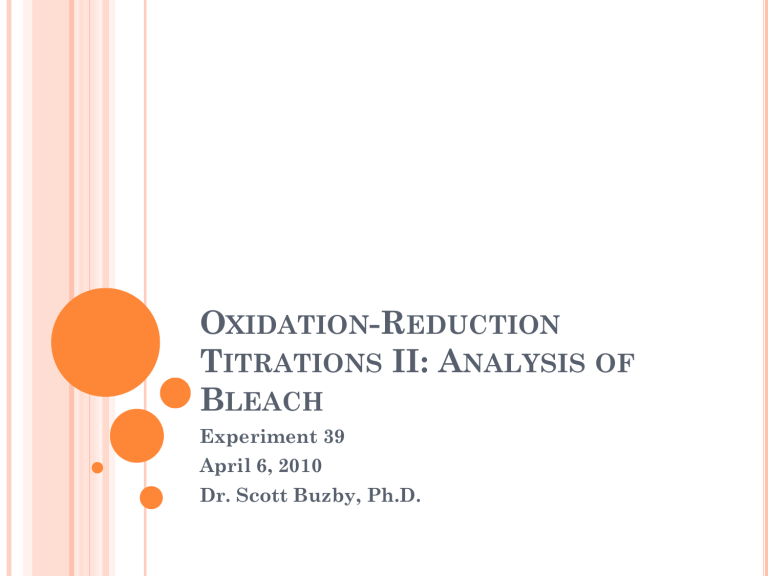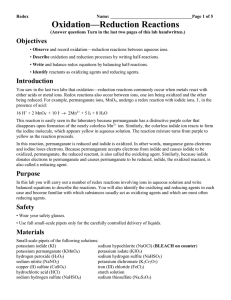Oxidation-Reduction Titrations II - Analysis of Bleach

O XIDATION -R EDUCTION
T ITRATIONS II: A NALYSIS OF
B LEACH
Experiment 39
April 6, 2010
Dr. Scott Buzby, Ph.D.
O BJECTIVES
Learn the basics of Oxidation-Reduction (redox) reactions
Show how redox reactions can be used to determine the amount of hypochlorite in household bleach
R EDOX REACTIONS
Redox (shorthand for reduction-oxidation reaction) describes all chemical reactions in which atoms have their oxidation number (oxidation state) changed
This can be a simple process such as the oxidation of carbon to yield carbon dioxide or it can be a complex process such as the oxidation of sugar in the human body
The term redox comes from the two concepts of reduction and oxidation
Oxidation is the loss of electrons or an increase in oxidation state by a molecule, atom, or ion
Reduction is the gain of electrons or a decrease in oxidation state by a molecule, atom, or ion
Non-redox reactions, which do not involve changes in formal charge, are known as metathesis reactions
O XIDIZING AND R EDUCING A GENTS
The chemical way to look at redox processes is that the reductant transfers electrons to the oxidant. Thus, in the reaction, the reductant or reducing agent loses electrons and is oxidized, and the oxidant or oxidizing agent gains electrons and is reduced
Remember OIL RIG…
Oxidation Is Loss and Reduction Is Gain
O XIDIZERS
Substances that have the ability to oxidize other substances are said to be oxidative and are known as oxidizing agents, oxidants, or oxidizers
Put another way, the oxidant removes electrons from another substance, and is thus itself reduced. And, because it "accepts" electrons, it is also called an electron acceptor
Oxidants are usually chemical substances with elements in high oxidation numbers (e.g., H
MnO −4 , CrO
3
, Cr
2
O
2
−7 , OsO
4
) or highly
2
O
2
, electronegative substances that can gain one or two extra electrons by oxidizing a substance (O,
F, Cl, Br)
R EDUCERS
Substances that have the ability to reduce other substances are said to be reductive and are known as reducing agents, reductants, or reducers
In other words, the reductant transfers electrons to another substance, and is thus itself oxidized.
And, because it "donates" electrons it is also called an electron donor.
P ROCEDURE ( PAGES 481 – 483)
Two redox reactions are involved in the experiment tonight
Initially you will add excess potassium iodide
(KI) to bleach so the iodide ions (I ) are oxidized to iodine (I
2
)
See Eq. 1 Page 479
The iodine is then titrated with a standardized sodium thiosulfate (Na
2
S
2
O
3
) that reduces the iodine (I
2
) to iodide (I
See Eq. 2 Page 479
)
Starch is used for the indicator for this reaction, the endpoint is reached when a drop of thiosulfate turns the solution clear
D UE N EXT W EEK
Report Sheet – Pages 485 – 486
(See Example 39.1 on Page 480)
Questions – Page 487
Pre-Lab Experiment 40 – Pages 492 – 493






